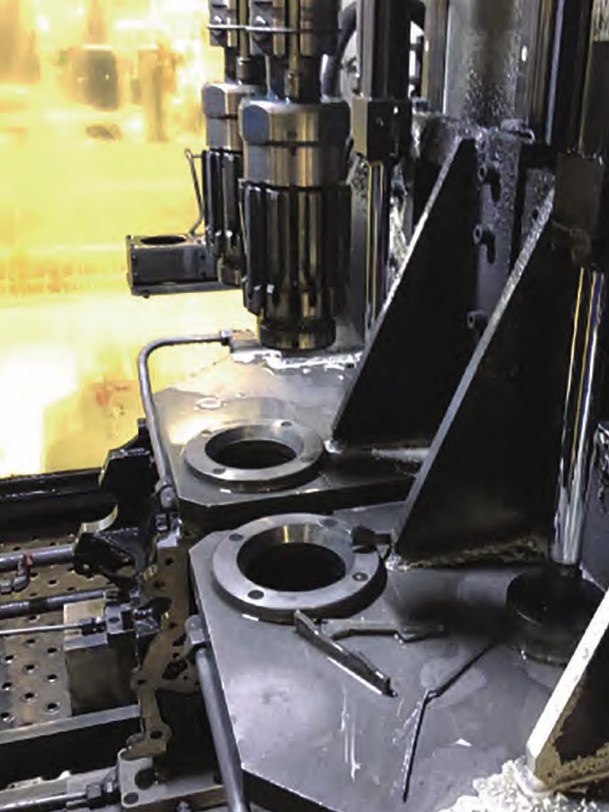1. Introduction
The engine cylinder block is a critical component in automotive manufacturing, and its machining quality directly impacts engine performance. Honing, a precision finishing process, ensures the required surface roughness and geometric accuracy of cylinder bores. However, tool sticking in honing machines remains a persistent challenge, leading to defects such as bore chamfer damage, tool breakage, and poor surface quality. This study investigates the root causes of tool jamming and proposes optimization strategies to enhance the reliability of engine cylinder block honing processes.

2. Problem Identification
2.1 Current Challenges
Tool sticking manifests as incomplete retraction of honing stones, causing collisions with the cylinder bore during machine operation. Common defects include:
- Bore Chamfer Damage: Unretracted tools scratch or chip bore edges.
- Surface Scratches: Broken tool fragments create deep grooves, leading to poor roughness (Ra > 0.8 µm).
- Workpiece Scrap: 15–20% of engine cylinder blocks are scrapped monthly due to these defects.
2.2 Statistical Analysis
Field data from a 9-month period highlights the frequency of tool jamming:
| Month | Jan | Feb | Mar | Apr | May | Jun | Jul | Aug | Sep |
|---|---|---|---|---|---|---|---|---|---|
| Jamming Cases | 12 | 15 | 18 | 20 | 22 | 19 | 17 | 14 | 10 |
Table 1: Monthly tool jamming incidents in engine cylinder block production.
3. Root Cause Analysis
A fishbone diagram identified six key factors influencing tool sticking:
- Tool Design
- Expansion Mechanism
- Honing Fluid Quality
- Workpiece Hardness
- Fixture Alignment
- Machining Parameters
3.1 Tool Expansion Mechanism
The expansion system comprises a servo motor, hydraulic cylinder, expansion rod, and springs. Key findings:
- Spring Fatigue: Retraction springs lose elasticity over time, reducing retraction force (F=k⋅xF=k⋅x, where kk = spring constant, xx = displacement).
- Contamination: Metal debris (≥400 ppm≥400ppm) in honing fluid increases friction between stones and tool guides.
3.2 Honing Fluid Contamination
Honing fluid samples revealed excessive impurities at tool nozzles (Table 2):
| Parameter | Standard | Nozzle Sample | Root Cause? |
|---|---|---|---|
| Impurity Content | <150 ppm | 400 ppm | Yes |
| pH | 8–9 | 8.5 | No |
| Concentration | 9–11% | 10% | No |
Table 2: Honing fluid quality analysis.
4. Optimization Strategies
4.1 Spring Reinforcement
Replacing conventional springs with high-stiffness Martensitic springs improved retraction force by 30%:Fnew=1.3⋅FoldFnew=1.3⋅Fold
4.2 Filtration System Upgrade
Installing 60 µm filters (vs. 90 µm) reduced impurity levels to 120 ppm, minimizing friction-induced jamming.
4.3 Process Parameter Validation
Critical parameters were recalibrated to ensure alignment with engine cylinder block tolerances:
| Parameter | Original Value | Optimized Value |
|---|---|---|
| Stroke Speed | 25 m/min | 22 m/min |
| Honing Pressure | 0.45 MPa | 0.40 MPa |
| Retraction Delay | 0.5 s | 0.3 s |
Table 3: Adjusted machining parameters.
5. Results and Validation
Post-optimization data demonstrated significant improvements:
- Tool Jamming Rate: Reduced by 65%.
- Surface Roughness: Ra improved from 1.2 µm to 0.6 µm.
- Scrap Rate: Dropped to 5%, saving $1.2M annually in engine cylinder block production.
6. Conclusion
Addressing tool sticking in honing machines requires a holistic approach, combining mechanical upgrades, fluid management, and parameter optimization. These measures not only enhance the machining quality of engine cylinder blocks but also bolster production efficiency. Future work will focus on AI-driven predictive maintenance to further mitigate tool-related failures.
